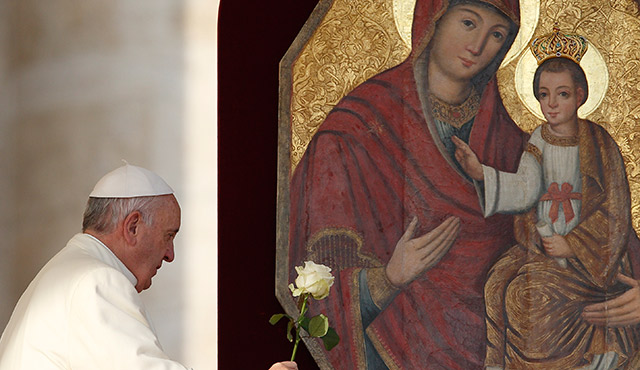To many, New Year’s Day is a time for making resolutions or renewing promises big and small.
But Jan. 1 is also a day of spiritual reaffirmation for Catholics who commemorate the Solemnity of Mary, a feast day celebrating Mary as the Mother of God.
The Solemnity of Mary is among the highest-ranked solemnities, or special days in the liturgical calendar of the Roman Catholic rite.
Mary’s significance as Mother of God was formally announced at The Council of Ephesus in 431 A.D. at which theologians defended Mary’s title as ‘Theotokos,’ which is Greek for God-bearer.
“It’s very important because it’s not so much about the Mother of God, Mary; it’s more about Jesus Christ and the early church,” says Fr. Troy Schneider, parochial vicar at Holy Family Cathedral in Orange.
“They were left with the question, ‘Well, who was Jesus? Was He God, or was He man? Or was He both?’” says Schneider, who earned his bachelor’s, master’s and advanced master’s degree in theology and religious studies from the Catholic University of Leuven, specializing in early church history. “To this day, we believe that He’s both, but there, they formally announced Mary as the Mother of God and to say Jesus Christ … is human and divine.”
For years some semblance of this particular solemnity was celebrated by many countries on various days ranging from May to January. It later became a universal feast day on Oct. 11 in 1931.
After Vatican II, however, Pope Paul VI moved the Solemnity of Mary to Jan. 1.
“The purpose of the celebration is to honor the role of Mary in the mystery of salvation and at the same time to sing the praises of the unique dignity thus coming to ‘the Holy Mother…through whom we have been given the gift of the Author of life,’” according to the pope in the 1974 Marialis Cultus. “This same solemnity also offers an excellent opportunity to renew the adoration rightfully to be shown to the newborn Prince of Peace, as we once again hear the good tidings of great joy and pray to God, through the intercession of the Queen of Peace, for the priceless gift of peace.”
To further reinforce this sentiment, Pope Paul VI also assigned the solemnity on the World Day of Peace because it also landed on New Year’s Day, considered a day of hope.
“The fact that it’s on Jan. 1 speaks of that journey of faith that only we as Christians made,” Schneider says. “There’s an affirmation that, yes, He was fully God and fully man. It’s placing a stamp or a seal on that belief by celebrating this solemnity very quickly after Christmas.”
Technically, every Sunday is considered a solemnity, but there are other celebrations that rank as a solemnity, depending on where one lives and what particular patron represents one’s country, city or diocese, Schneider says.
“For example, Our Lady of Guadalupe is not a solemnity in the universal Church,” Troy says, referring to the Dec. 12 feast day in which Mary appeared before the Aztec Indian Juan Diego. “But it is (recognized) here in the Diocese of Orange and in Mexico, where She’s a patroness.”
Only a select number of solemnities are universally acknowledged by the Church, including Epiphany, the Nativity of St. John the Baptist, and All Saints Day.
“All of these solemnities point to Jesus Christ by the example of whomever we happen to be celebrating,” Schneider says.
And because of its high ranking, liturgically speaking, churches pull out all the stops for solemnities. Parts of the Mass that aren’t usually sung are sung. The big music is performed.
“You bring out the bells and the smells, as they say,” Schneider says. “These are moments for us to take it to another level when it comes to the liturgy. These are special days that should be days of focusing, of really concentrating on the level of what’s going on at this particular point.”
To commemorate the Solemnity of Mary, Schneider recommends pondering Mary’s importance in one’s life and the life of Christ.
“As Catholics, we treat Mary, the Mother of God, as our mother, that she represents this relationship of welcoming Christ, pointing to Christ in our lives through the difficult and the joyful times,” he says. “As we celebrate the solemnity, we should meditate on that comforting mother who welcomed Christ into the world, which at the time did not want Him. She welcomed him, confident and trusting, knowing that the promises of old were fulfilled.”

